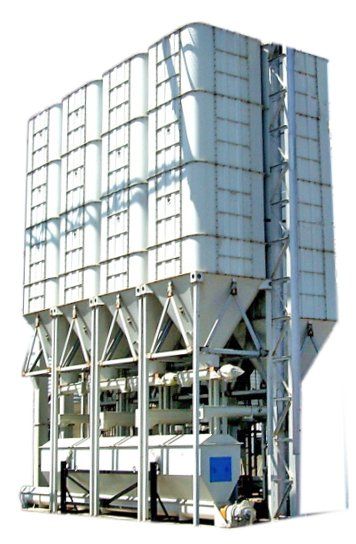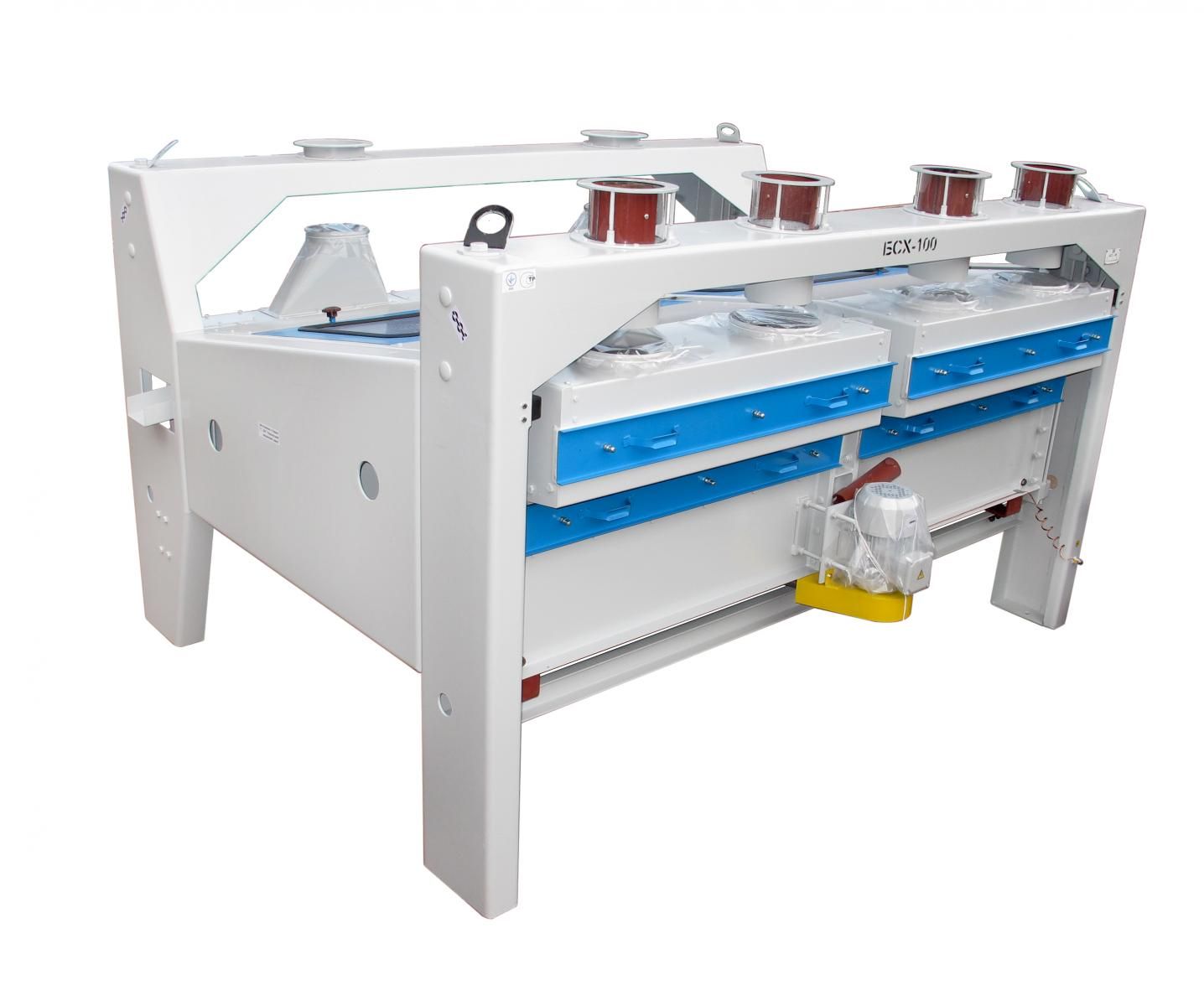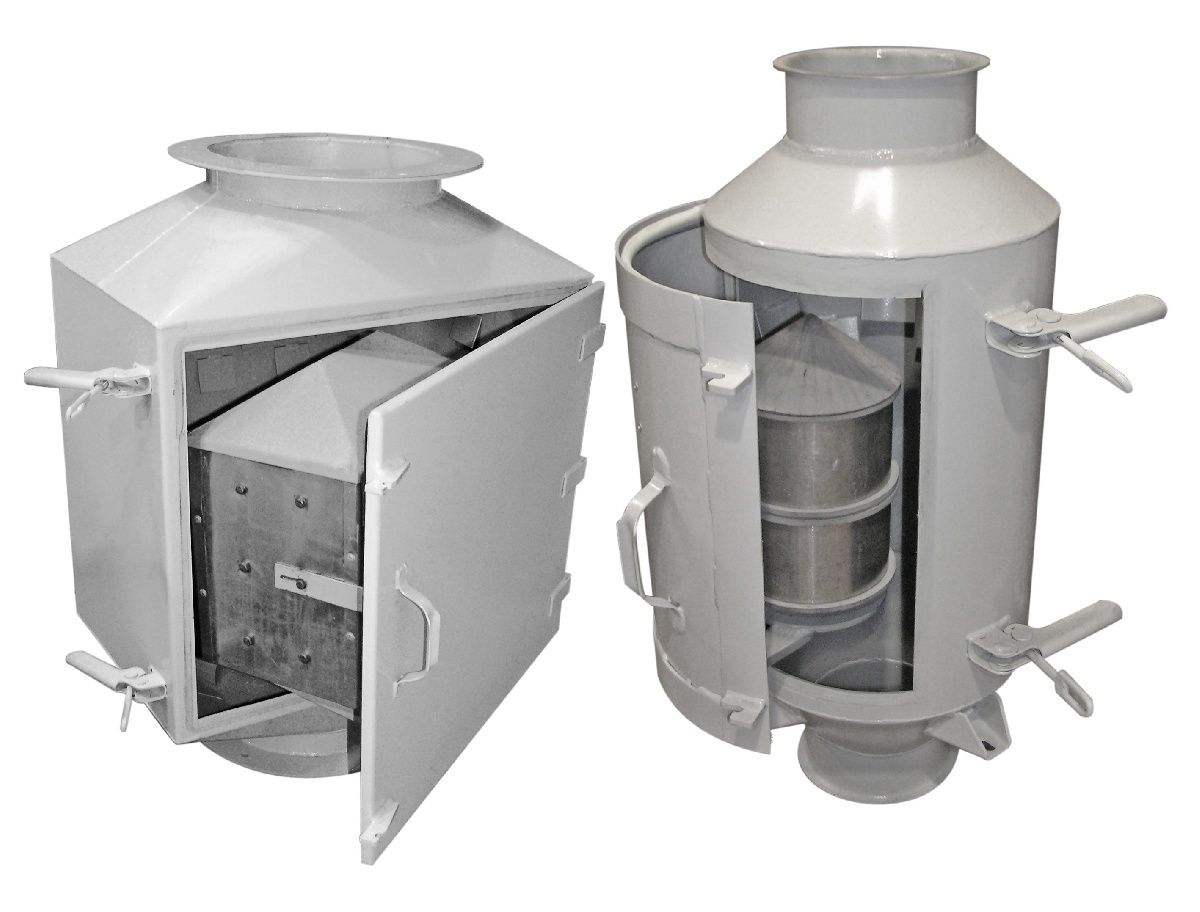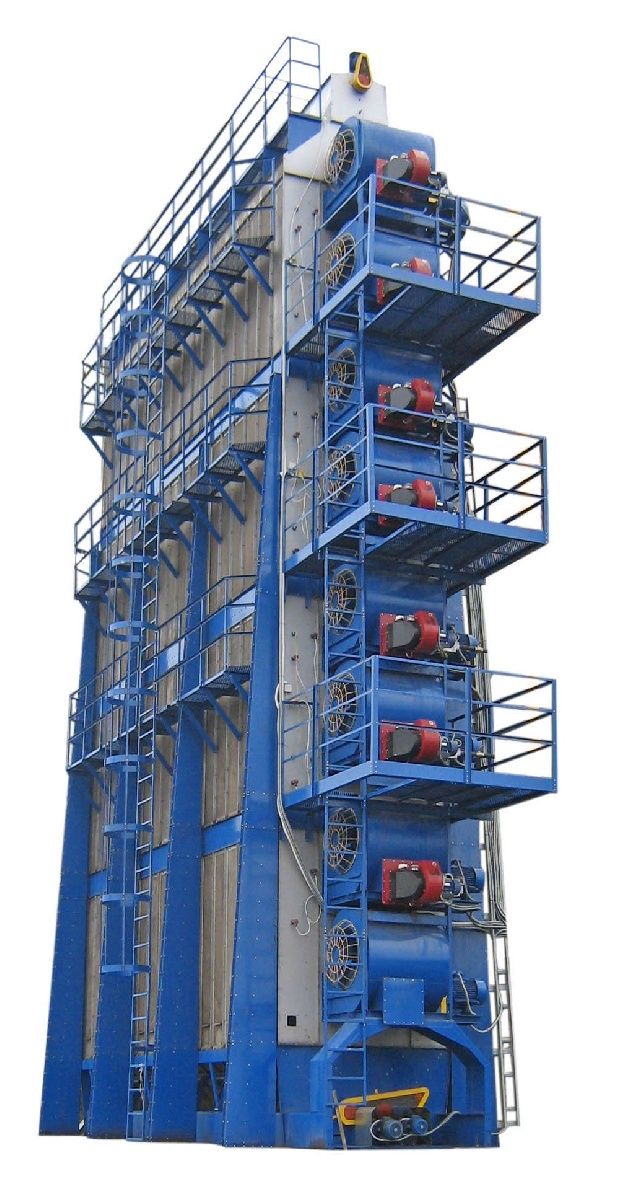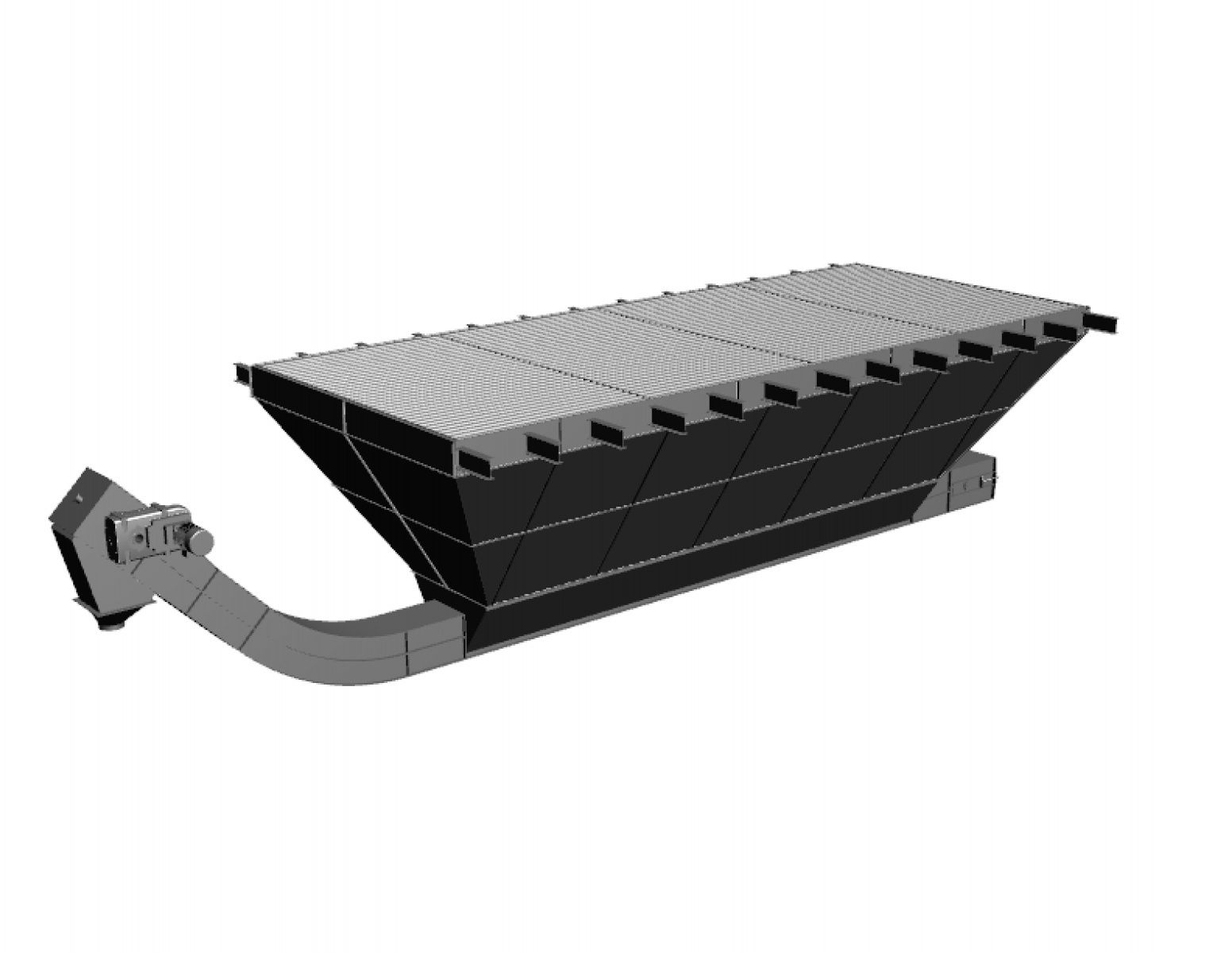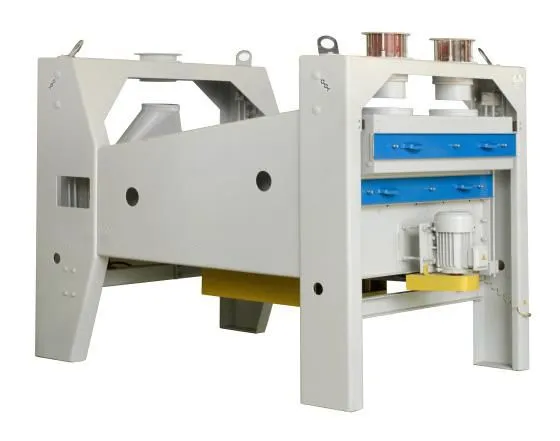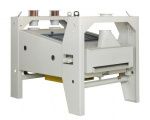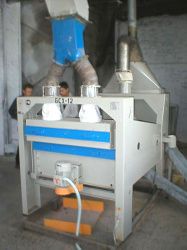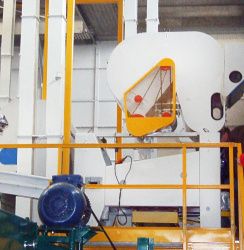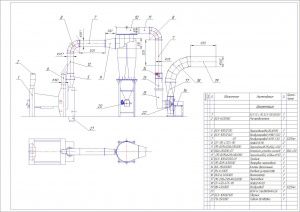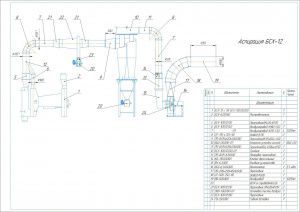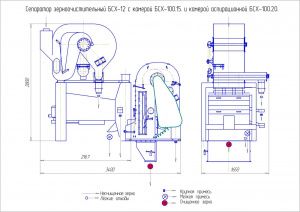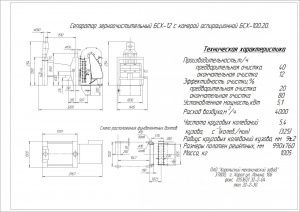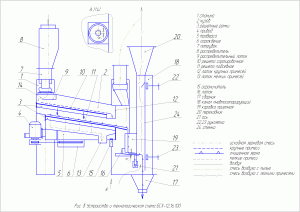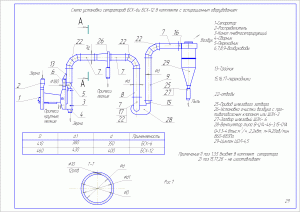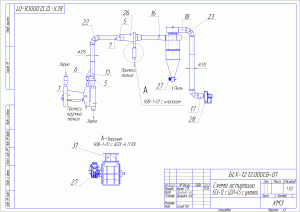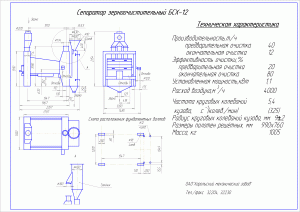Призначення виробу
Сепаратор зерноочищувальний марки БСХ-12 (далі – сепаратор) призначений для очищення зерна (пшениці, жита, вівса та ін) від домішок, що відрізняються від нього геометричними розмірами та аеродинамічними властивостями. Сепаратори встановлюються в складі технологічних схем на млинах, елеваторах і крупозаводах.
Сепаратор виготовляється по 3-ій категорії ГОСТ 15150 в кліматичному виконанні «У» для внутрішнього ринку та експорту в країни з помірним кліматом. При цьому сепаратор надійно працює в робочих режимах при температурі від мінус 10 до плюс 40°С, відносної вологості 80% при середньорічній температурі плюс 15°С, атмосферному тиску від 650 до 800 мм. рт.ст. (86,6÷106,7 кПа). При застосуванні спеціальних консистентних мастил сепаратор запускається і надійно працює при температурі від мінус 30°С.
Порівняння параметрів сепараторів марки БСХ
|
Найменування параметра
|
Значення параметра
|
|
БСХ-3
|
БСХ-6
|
БСХ-12
|
БСХ-16
|
БСХ-100
|
|
Продуктивність технічна,
(для пшениці вологістю до 15% і вмістом засмічених домішок до 3%)
- при попередньому очищенні (елеваторний режим),т/год:
|
12
|
25
|
40
|
50
|
80
|
|
- при остаточному очищенні (млиновий режим), т/год
|
3
|
6
|
12
|
16
|
24
|
|
Еффективність очищення від засмічених домішок, %, не менше:
(для пшениці вологістю до 15% і вмістом засмічених домішок до 3%)
- при попередньому очищенні
|
20
|
20
|
20
|
20
|
20
|
|
- при остаточному очищенні
|
80
|
75
|
80
|
75
|
80
|
|
Встановлена потужність, кВт, не більше
|
0,75
|
0,75
|
1,1
|
1,1
|
1,5
|
|
Загальна витрата повітря, м3/год, не більше:
|
600
|
4000
|
4000
|
8200
|
8500
|
|
- на пневмосепарування;
- на аспірацію кузова
|
-
600
|
3400
600
|
3400
600
|
7000
1200
|
7300
1200
|
|
Частота кругових коливань решітного кузова, С-1
|
5,4
|
5,4
|
5,4
|
5,4
|
6,25
|
|
або (кол/хв)
|
(325)
|
(325)
|
(325)
|
(325)
|
(375)
|
|
Діаметр кругових коливань кузова, мм, не більше
|
18±1
|
18±1
|
18±1
|
18±1
|
20±1
|
|
Габаритні розміри сепаратора без циклону, мм, не більше:
- довжина
- ширина
- висота
|
1530
1185
1440
|
1900
1485
2104
|
2457
1485
2154
|
1900
2772
2104
|
2457
2772
2154
|
|
Займана площа, м2, не більше
|
1,6
|
2,5
|
3,2
|
4,7
|
6,0
|
|
Маса кг, не більше
|
590
|
815
|
1015
|
1450
|
1583
|
|
Термін служби,не менше, років
|
8
|
8
|
8
|
8
|
8
|
*Для очищення інших культур, відмінних від пшениці, продуктивність зменшується таким чином:
- для жита і кукурудзи - до 90%;
- для проса і ячменю - до 80%;
- для гречки та вівса – до 70%;
- для соняшника - до 12% від номінальної.
Продуктивність сепараторів, при збільшеній засміченості та вологості зерна знижується, наприклад:
- при вологості 15-18% до 65-70%;
- при вологості 18-22% до 55-60%;
- при вологості понад 22% до 50% номінальної.
Комплект поставки. Сепаратор поставляється в зібраному вигляді.
|
Позначення
|
Найменування
|
Кількість на один сепаратор
|
Примітка
|
|
БСХ-3
|
БСХ- 6
|
БСХ-12
|
БСХ-16
|
БСХ-100
|
|
БСХ- 3.00.000.
|
Сепаратор
|
1
|
-
|
-
|
-
|
-
|
|
|
БСХ-6.00.000.
|
Сепаратор
|
-
|
1
|
-
|
-
|
-
|
|
|
БСХ-12.00.000.
|
Сепаратор
|
-
|
-
|
1
|
-
|
-
|
|
|
БСХ-16.00.000.
|
Сепаратор
|
-
|
-
|
-
|
1
|
-
|
|
|
БСХ-100.00.000.
|
Сепаратор
|
-
|
-
|
-
|
-
|
1
|
|
|
БСХ-6.00.120.
|
Збірник
|
-
|
1
|
-
|
2
|
-
|
За окремим замовленням
|
|
БСХ-100.00.120
|
Збірник
|
-
|
-
|
1
|
-
|
2
|
|
БСХ-6.08.000.
|
Канал пневмосепаруючий (ПК)
|
-
|
1
|
-
|
-
|
-
|
|
|
БСХ-6.08.000-01
|
Канал пневмосепаруючий (ПК)
|
-
|
-
|
-
|
2
|
-
|
|
|
БСХ-100.08.000.
|
Канал пневмосепаруючий (ПК)
|
-
|
-
|
1
|
-
|
2
|
|
|
УОВ-1.00.000.
|
Установка очистки повітря
|
-
|
1
|
-
|
-
|
-
|
За окремим замовленням
|
|
УОВ-1.00.000-01.
|
Установка очистки повітря
|
-
|
-
|
1
|
2
|
2
|
|
БСХ-6.00.160.
|
Розподілювач
|
-
|
1
|
1
|
2
|
2
|
|
БСХ-6.12.030
|
Трійник аспірації
|
-
|
1
|
-
|
-
|
-
|
|
БСХ-16.12.030
|
Трійник аспірації
|
-
|
-
|
-
|
2
|
-
|
|
БСХ-100.12.030
|
Трійник аспірації
|
-
|
-
|
1
|
-
|
2
|
|
БСХ-6.00.013
|
Планка кріплення ПК до сепаратора
|
-
|
2
|
-
|
-
|
-
|
|
-01
|
Планка кріплення ПК до сепаратора
|
-
|
-
|
2
|
-
|
-
|
|
БСХ-100.00.013
|
Планка кріплення ПК до сепаратора
|
-
|
-
|
-
|
-
|
2
|
|
-01
|
Планка кріплення ПК до сепаратора
|
-
|
-
|
-
|
2
|
-
|
|
|
БСХ-3.11.000
|
Комплект пластин підкладних
|
1
|
1
|
1
|
1
|
1
|
|
БСХ.РЭ
|
Керівництво по експлуатації
|
1
|
1
|
1
|
1
|
1
|
|
|
|
|
|
|
|
|
| |
|
ІНСТРУМЕНТ
|
|
БСХ-3.08.000
|
Ключ
|
1
|
1
|
1
|
1
|
1
|
|
|
ШВИДКОЗНОШУВАНІ ЗАПАСНІ ЧАСТИНИ
|
|
|
Комплект рамок
|
2
|
2
|
4
|
4
|
8
|
За окремим замовленням
|
|
|
Комплект підвісок
|
4
|
4
|
8
|
8
|
8
|
|
|
Комплект шариків
|
72
|
10
|
18
|
21
|
36
|
|
БСХ-3.00.036-А
|
Скло
|
1
|
2
|
2
|
4
|
4
|
|
БСХ-3.00.040
|
Рукав
|
1
|
2
|
-
|
4
|
-
|
|
БСХ-3.00.040-02
|
Рукав
|
-
|
-
|
2
|
-
|
4
|
|
БСХ-3.00.090
|
Рукав
|
1
|
1
|
-
|
2
|
-
|
|
БСХ-3.00.090-01
|
Рукав
|
-
|
-
|
1
|
-
|
2
|
|
БСХ-3.00.080
|
Рукав
|
1
|
-
|
-
|
-
|
-
|
* За замовленням споживача замість каналу пневмосепаруючого сепаратори БСХ-12 можуть поставлятися з камерою аспіраційною БСХ-100.20.000 в тій же кількості.
Пристрій і робота
Зерноочищувальний сепаратор БСХ-12 складається з решітного сепаратора і пневмосепаруючого каналу, до яких приєднано допоміжне обладнання: розподілювач, перехідник і збірник зерна.
Сепаратор складається з наступних вузлів: станини, кузова з рамками сит, приводу, траверси з балансирним механізмом. Кузов підвішується до станини на гнучких підвісках. Підвіски виконані зі склопластику однонаправленого марки ССО-ВП діаметром 12 мм по ТУ 6-11-585-84. Інші матеріали ЗАБОРОНЯЄТЬСЯ застосовувати!
Рамки сит вставляються в кузов по направляючим, закріпленим на боковинах кузова, і фіксуються нерухомо за допомогою притисків. Регулювання механізму притиску проводиться в повністю відкритому положенні так, що зазор між поверхнями прокладок притисків і площиною верхньої рамки повинен бути 3±0,5 мм. Притиски переміщуються спеціальним ексцентриковим пристроєм – ключем, що входить в комплект поставки. При цьому здійснюється поворот ексцентрикових втулок, внаслідок чого забезпечується вертикальне переміщення валиків і притисків і, таким чином, затискання та звільнення рамок сит. З метою забезпечення одночасного затиснення та звільнення верхньої і нижньої меж, валики з обох боків кузова пов'язані важелями. При звільненні рамок сит притиски відходять на 3-4 мм від сит, в результаті чого забезпечується демонтаж рамок.
Каркаси рамок розділені поздовжніми і поперечними перегородками на комірки, у яких розміщуються гумові кульки, призначені для очищення решіт від забруднення. Установка ситових рам уздовж кузова проводиться наступним чином: відпустити гайки і, повертаючи гайки, переміщати ситові рами за допомогою болтів таким чином, щоб верхнє решето лягало на лоток, а нижнє - на задню нижню частину сепаратора для сходу очищеного зерна. Після цього гайками поз.2 фіксується положення решіт.
УВАГА! На сепараторах БСХ-12 (аналогічно і на БСХ-100) решето передньої рамки повинно лягати на каркас задньої рамки.
На передній стінці решітного кузова встановлено електродвигун з приводним шківом, який через клинопасову передачу приводить в обертання шків із закріпленим на ньому дисбалансним вантажем, що забезпечує круговий рух решітного кузова. Шків вільно обертається на підшипниках, встановлених на осі, запресованої в траверсу. Підшипники закриті кришками. Мастило підшипників здійснюється через маслянку, розташовану на ступиці шківа.
Зверху, в передній частині кузова розташовані патрубки для подачі у кузов продукту, що сортується. Є розподільний лоток, що сприяє рівномірному розподілу продукту по ширині решіт. Станина сепаратора складається з передньої і задньої стійок, з'єднаних між собою боковинами. На передній стійці встановлені патрубки для подачі продукту в сепаратор, обладнані оглядовими вікнами. На задній стійці станини кріпиться патрубок для приєднання до аспіраційної мережі. З метою запобігання можливих ударів кузова об станину при пуску і зупинці машини, на нижньому задньому з'єднанні станини закріплений обмежувач з гумовим амортизатором. Для цієї мети служать і два гумових обмежувача, які закріплені на передній стійці станини.
Пневмосепаруючий канал служить для виділення з продукту легких домішок. Він складається з корпусу, всередині якого встановлено рухома стінка. Переміщення нижньої і верхньої рухомої частини стінки забезпечується поворотом рукоятки. Регулювання витрати повітря здійснюється дросельним клапаном за допомогою ручки. Рухома стінка виконана з прозорого матеріалу (або з оглядовим вікном, якщо стінка непрозора) для спостереження процесу сепарування. Для рівномірної подачі продукту в пневмоканал передбачена приймальна коробка з лотком. Зверху на корпусі каналу встановлюється перехідник для під'єднання до повітропроводу, під каналом збірник для сходу очищеного зерна. Розподільник призначений для розділення вихідного зерна на два однакових потоки, що забезпечує рівномірний розподіл зерна по ширині решіт сепаратора. Поділ зерна забезпечується з допомогою рухомого клапана з вантажами. Рівномірність потоку зерна регулюється переміщенням вантажу на шпильці.
Принцип роботи сепаратора полягає в наступному. Очищаємий продукт через приймальний патрубок надходить у розподільник, звідки з допомогою патрубків розділяється на два потоки і направляється в секцію кузова. УВАГА! Щоб уникнути перекосу кузова в процесі роботи необхідно забезпечити постійну однакову подачу зерна в кожен потік. Кузов сепаратора здійснює кругові рухи, під впливом яких продукт переміщається по решету і сортується. У кузові є фартух, який зменшує можливість потрапляння зерна у відходи.
Великі домішки виводяться з сепаратора через лотки, а суміш зерна з дрібними домішками проходом через сортувальне сито поступає на нижню рамку сит. Дрібні домішки, просіявшись через підсівне решето, потрапляють на дно сепаратора, а потім через лоток, виводяться із машини. Очищене на решетах від великих і дрібних домішок зерно надходить у приймач пневмосепаруючого каналу, звідки з допомогою лотка рівномірним потоком подається в пневмосепаруючий канал, де продукт інтенсивно охолоджується повітряним потоком. Повністю очищене зерно через нижній збірник виводиться з машини. Повітря з кузова і пневмосепаруючого каналу направляється по воздуховодам в циклон для очищення від аспіраційних домішок.
Рекомендовані схеми установки сепараторів в комплекті з аспіраційним устаткуванням наведено у розділі "ФОТО". Сепаратори можуть працювати як в елеваторному (попереднє очищення продукту), так і в млиновому (остаточна очистка) режимах в залежності від типів решіт.
Для очищення зерна від домішок, що відрізняються від нього розмірами, в сепараторі можуть використовуватися решета з круглими, довгастими або трикутними отворами, відповідними за формою і розмірам зерна основної культури та забруднюючих домішок. Рекомендовані розміри і типи решіт наведено в додатку. Продуктивність сепаратора знижується при збільшенні вологості та засміченості зерна.
УВАГА! Підбір решіт, з метою одержання необхідного ступеня очищення, здійснюється споживачем за місцем експлуатації сепаратора в залежності від вихідного продукту і його властивостей (вологість, засміченість, фракційний склад тощо).
|
НАЙМЕНУВАННЯ КУЛЬТУРИ
|
ЕЛЕВАТОРНИЙ РЕЖИМ
|
МЛИНОВИЙ РЕЖИМ
|
|
Сортувальне
сито
|
Підсівне
сито
|
Сортувальне
сито
|
Підсівне
сито
|
|
Пшениця
|
Ø13÷8
|
1,7…2х20(16)
Ø2÷2,5
|
Ø7÷5
3…4х20(16)
|
1,7…2х20(16)
Ø2÷2,5
|
|
Жито
|
Ø13÷8
|
1,7…2х20
Ø2÷2,5
|
Ø7÷5
3…4х20
|
1,7…2х20
Ø2÷2,5
|
|
Ячмінь
|
Ø13÷8
|
2…2,4х20
Ø2,5
|
Ø8÷4,5
4…4.5х20
|
2…2,4х20
Ø2,5
|
|
Овес
|
Ø10÷8
|
1,7…2,2х20
Ø2,5
|
Ø8÷6
3…4х20
|
1,7…2,2х20
Ø2,5
|
|
Рис
|
Ø13÷8
|
Ø2,5÷3,5
|
Ø6,5÷5,5
2,8…3,6х20
|
Ø2,5÷3,5
|
|
Гречка
|
Ø9÷7
|
2…2,4х20
Ø3÷3,6
|
Ø6÷5
|
2…2,4х20
Ø3÷3,6
|
|
Просо
|
Ø8÷6
|
1,4…1,6х20
|
Ø4÷3
2…2,2х20
|
1,4…1,6х20
|
|
Горох
|
Ø16÷8
|
2,7…4х20
Ø5÷5,5
|
Ø10÷8
|
2,7…4х20
Ø5÷5,5
|
|
Соняшник
|
Ø16÷8
|
1,7…3х20
Ø3,5
|
Ø10÷6
|
1,7…3х20
Ø3,5
|
|
Кукурудза
|
Ø16÷10
|
3…5х20
Ø6÷5,5
|
Ø12÷10
|
3…5х20
Ø6÷5,5
|
|
|
|
|
|
|
|
Соя
|
Ø13÷10
|
3,0х25
Ø4
|
Ø9÷8
|
3,0х25
Ø4
|
|
Льон
|
Ø6÷5
|
Ø2÷2,5
|
Ø4÷3,6
|
Ø2,5÷2
|
|
Рапс
|
Ø8÷6
|
0,9…1,2х10
|
Ø3,5÷3,2
|
0,9…1,2х10
|
|
Гірчиця
|
Ø6÷5
|
1,1х12
|
Ø4÷3
|
0,9…1,2х10
|
Примітка*. У разі необхідності довгасті отвори можуть бути замінені круглими і навпаки, з урахуванням формули:
В=(0,70…0,75)d,
де В – ширина довгастого отвору; d – діаметр отвору.
Примітка*. Для забезпечення необхідного ступеня очищення і отримання необхідної продуктивності сортувальні і підсівні сита підбираються споживачами індивідуально в процесі експлуатації, оскільки геометричні характеристики одних і тих же видів зернових культур можуть відрізнятися в залежності від сорту і зони вирощування.


